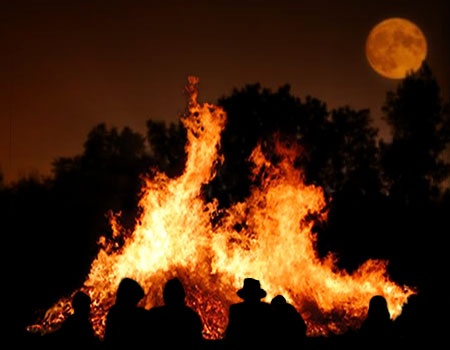
I am getting excited! Each day the veil that separates the world of the living and the world of the dead is slowly being pulled back. Soon, the dead will walk among the living! Things around the cemetery surely get much more interesting on Halloween night.
When people think of the ancient origins of Halloween they often refer to the Celtic festival of Samhain. The Celts lived over 2,000 years ago. They lived in the areas that are now Ireland, England and France. On October 31st, they celebrated Samhain, a harvest festival – and also a day that they believed the boundaries of life and death were blurred. In addition to great feasts, wearing costumes of animal skins and heads, and lighting bonfires, the Celts also believed that this was a perfect time of year to make predictions. With spirits nearby, they believed that it was easier for Druids/Celtic priests to predict future outcomes of events.
However, Samhain is thought by some to be the combination of several festivals that were celebrated way before the ancient Celts. It is believed that what eventually became Samhain, and today our Halloween, was a mix of several ancient Roman festivals – Parentalia, Feralia and the festival of Pomona.
Parentalia was a nine-day festival that was held in early February and honored the family’s ancestors. Offerings of flowers, bread, wine and sweets were left on family tombs during this time. The day after Parentalia ended the festival of Feralia began. Feralia celebrated the Manes, or the spirits of the Roman dead. Families would hold banquets on Feralia as a way to celebrate with their dead. The festival of Pomona came later in the summer in August. Pomona was the Roman goddess of fruit and abundance. While she is not directly associated with the harvest, she is associated with the flourishing of fruit. In paintings and sculptures she is typically depicted with plates of fruit, and is often associated with apples. Bobbing for apples anyone?
From Parentalia to Feralia, to Pomona we were given Samhain in late October. As Christianity spread, the Catholic Church instituted All Saint’s Day to commemorate saints and martyrs and shortly after All Soul’s Day to honor all of those who have died.
So, how did we go from bonfires and animal skins, saints and martyrs, to costume parties and candy? We will talk more about that tomorrow, but remember still friends… ancient people of varying backgrounds and cultures believed that lines are blurred October 31st. Do you believe lines will fade and the dead will be close enough to you this day to whisper in your ear? We shall see.
-Gravedigger



I just want to say – I love this blog!!!